
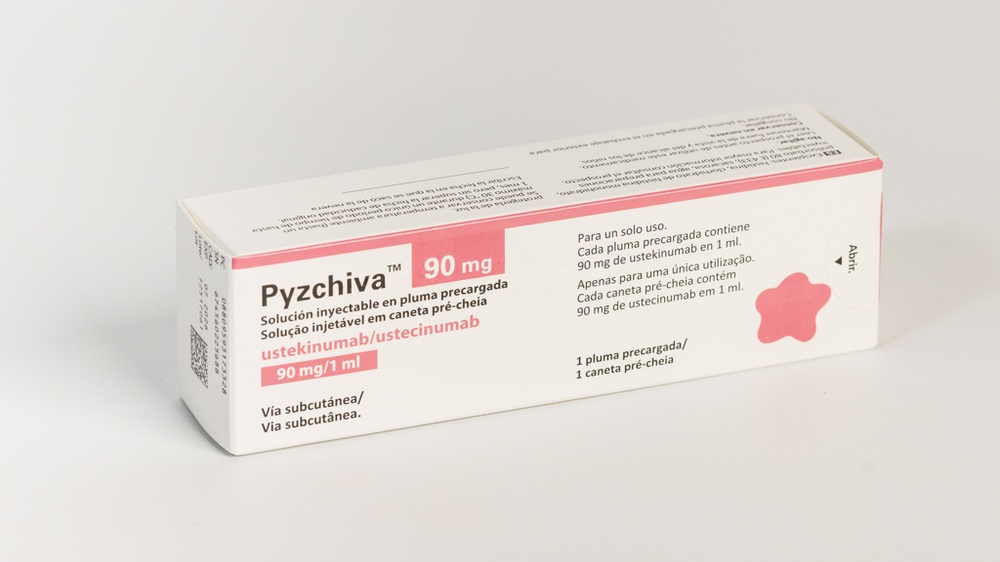
PYZCHIVA 90 mg SOLUTION FOR INJECTION IN PRE-FILLED PEN


How to use PYZCHIVA 90 mg SOLUTION FOR INJECTION IN PRE-FILLED PEN
Introduction
Package Leaflet: Information for the Patient
Pyzchiva 90mg solution for injection in pre-filled pen
ustekinumab
This medicinal product is subject to additional monitoring, which will allow for quick identification of new safety information. You can help by reporting any side effects you may get. The last section of this leaflet includes information on how to report side effects.
Read all of this leaflet carefully before you start using this medicine, because it contains important information for you.
This leaflet has been written for the person taking the medicine.
- Keep this leaflet, you may need to read it again.
- If you have any further questions, ask your doctor or pharmacist.
- This medicine has been prescribed for you only. Do not pass it on to others. It may harm them, even if their signs of illness are the same as yours.
- If you get any side effects, talk to your doctor or pharmacist. This includes any possible side effects not listed in this leaflet. See section 4.
Contents of the pack
- What is Pyzchiva and what is it used for
- What you need to know before you use Pyzchiva
- How to use Pyzchiva
- Possible side effects
- Storage of Pyzchiva
- Contents of the pack and other information
1. What is Pyzchiva and what is it used for
What is Pyzchiva
Pyzchiva administered with the pre-filled pen contains the active substance “ustekinumab”, a monoclonal antibody. Monoclonal antibodies are proteins that identify and bind specifically to certain proteins in the body.
Pyzchiva belongs to a group of medicines called “immunosuppressants”. These medicines work by weakening part of the immune system.
What is Pyzchiva used for
Pyzchiva administered with the pre-filled pen is used to treat the following inflammatory diseases:
- Plaque psoriasis – in adults
- Psoriatic arthritis – in adults
- Moderate to severe Crohn's disease – in adults
Plaque psoriasis
Plaque psoriasis is a skin disease that causes inflammation affecting the skin and nails. Pyzchiva reduces inflammation and other signs of the disease.
Pyzchiva administered with the pre-filled pen is used in adults with moderate to severe plaque psoriasis who cannot use cyclosporin, methotrexate, or phototherapy, or when these treatments do not work.
Psoriatic arthritis
Psoriatic arthritis is an inflammatory disease of the joints, which is usually accompanied by psoriasis. If you have active psoriatic arthritis, you will first receive other medicines. If you do not respond well to these medicines, you may be treated with Pyzchiva to:
- Reduce the signs and symptoms of your disease.
- Improve your physical function.
- Reduce damage to your joints.
Crohn's disease
Crohn's disease is an inflammatory disease of the intestine. If you have Crohn's disease, you will first be given other medicines. If you do not respond adequately or cannot tolerate these medicines, you may be given Pyzchiva to reduce the signs and symptoms of your disease.
2. What you need to know before you use Pyzchiva
Do not use Pyzchiva
- If you are allergic to ustekinumabor to any of the other ingredients of this medicine (listed in section 6).
- If you have an active infectionthat your doctor thinks is important.
If you are not sure if any of the above applies to you, talk to your doctor or pharmacist before using Pyzchiva.
Warnings and precautions
Talk to your doctor or pharmacist before starting Pyzchiva. Your doctor will check how you are before each treatment. Make sure you tell your doctor about any illness you have before each treatment. Your doctor will also ask you if you have recently been near someone who may have tuberculosis. Your doctor will examine you and do a test to check for tuberculosis before you use Pyzchiva. If your doctor thinks you are at risk of tuberculosis, they may give you medicines to treat it.
Watch for serious side effects
Pyzchiva may cause serious side effects, including allergic reactions and infections. You should be aware of certain signs of illness while you are using Pyzchiva. See the complete list of these side effects in “Serious side effects” in section 4.
Tell your doctor before using Pyzchiva:
- If you have ever had an allergic reaction to ustekinumab.Check with your doctor if you are not sure.
- If you have ever had any type of cancer– this is because immunosuppressants like ustekinumab weaken part of the immune system. This may increase the risk of having cancer.
- If you have received treatment for psoriasis with other biologics (a medicine made from a biological source and usually given by injection)– the risk of having cancer may be higher.
- If you have had a recent infection.
- If you have any new or changing lesionswithin the area of psoriasis or on intact skin.
- If you are taking any other treatment for psoriasis and/or psoriatic arthritis– such as any other immunosuppressant or phototherapy (when your body is treated with a type of ultraviolet (UV) light). These treatments may also weaken part of the immune system. The use of these treatments together with ustekinumab has not been studied. However, it may increase the likelihood of suffering from illnesses related to a weaker immune system.
- If you are receiving or have ever received allergy shots– it is not known if ustekinumab can affect these treatments.
- If you are 65 years of age or older– you are more likely to get infections.
If you are not sure if you have any of these conditions, talk to your doctor or pharmacist before using Pyzchiva.
Some patients have experienced lupus-like reactions during treatment with ustekinumab, including cutaneous lupus or lupus-like syndrome. Talk to your doctor immediately if you experience a red, raised, and scaly skin rash, sometimes with a darker border, in areas of skin exposed to the sun or if accompanied by joint pain.
Heart attacks and strokes
In a study in patients with psoriasis treated with ustekinumab, heart attacks and strokes have been observed. Your doctor will regularly check your risk factors for heart disease and stroke to ensure they are being treated properly. Seek medical attention immediately if you experience chest pain, weakness, or an unusual feeling on one side of your body, facial paralysis, or abnormalities in speech or vision.
Children and adolescents
The use of ustekinumab in pre-filled pen is not recommended in children and adolescents under 18 years of age with psoriasis, as it has not been studied in this age group. For children from 6 years of age and adolescents with psoriasis, the pre-filled syringe or vial should be used instead.
The use of ustekinumab is not recommended in children and adolescents under 18 years of age with psoriatic arthritis or Crohn's disease, as it has not been studied in this age group.
Using Pyzchiva with other medicines, vaccines
Tell your doctor or pharmacist:
- If you are using, have recently used, or might use other medicines.
- If you have been vaccinated recently or are going to have a vaccination. Certain types of vaccines (live vaccines) should not be given while you are using Pyzchiva.
- If you received Pyzchiva during pregnancy, inform your baby's doctor about your treatment with Pyzchiva before your baby receives any vaccination, including live vaccines such as the BCG vaccine (used to prevent tuberculosis). Live vaccines are not recommended for your baby in the first 12 months after birth if you received Pyzchiva during pregnancy, unless your baby's doctor recommends otherwise.
Pregnancy and breastfeeding
- If you are pregnant, think you may be pregnant, or are planning to have a baby, ask your doctor for advice before taking this medicine.
- No increased risk of congenital anomalies has been observed in babies exposed to ustekinumab in the womb. However, experience with ustekinumab in pregnant women is limited. Therefore, it is preferable to avoid the use of ustekinumab during pregnancy.
- If you are a woman who can become pregnant, you are advised to avoid becoming pregnant and to use adequate contraceptive methods while using ustekinumab and for at least 15 weeks after the last treatment with ustekinumab.
- Pyzchiva may pass through the placenta to the fetus. If you received Pyzchiva during pregnancy, your baby may have a higher risk of getting an infection.
- It is important that you inform your baby's doctors and other healthcare professionals if you received Pyzchiva during your pregnancy before your baby receives any vaccination. Live vaccines, such as the BCG vaccine (used to prevent tuberculosis), are not recommended for your baby in the first 12 months after birth if you received Pyzchiva during pregnancy, unless your baby's doctor recommends otherwise.
- Ustekinumab may be excreted in breast milk in very small amounts. If you are breastfeeding or plan to breastfeed, tell your doctor. You and your doctor will decide if you should breastfeed or use ustekinumab. Do not do both.
Driving and using machines
Ustekinumab has no or negligible influence on the ability to drive and use machines.
Pyzchiva contains polysorbate 80 (E433)
This medicine contains 0.04 mg of polysorbate 80 (E433) in each pre-filled pen (1 ml), equivalent to 0.04 mg. Polysorbates may cause allergic reactions. Tell your doctor if you have any known allergy.
3. How to use Pyzchiva
Pyzchiva should be used under the guidance and supervision of a doctor with experience in the treatment of the conditions for which Pyzchiva is indicated.
Always follow exactly the administration instructions of this medicine given by your doctor. If you are not sure, ask your doctor. Ask your doctor when you should have the injections and about follow-up appointments.
How much Pyzchiva is given
Your doctor will decide how much Pyzchiva you need to use and the duration of treatment.
Adults aged 18 years and older
Psoriasis or psoriatic arthritis
- The recommended starting dose is 45 mg of Pyzchiva. Patients who weigh more than 100 kilograms (kg) may start with a dose of 90 mg instead of 45 mg.
- After the initial dose, you will take the next dose 4 weeks later and then every 12 weeks. The following doses are usually the same as the starting dose.
Crohn's disease
- During treatment, your doctor will give you the first dose of approximately 6 mg/kg of Pyzchiva through a drip in a vein in your arm (intravenous infusion). After the initial dose, you will receive the next dose of 90 mg of Pyzchiva 8 weeks later and then every 12 weeks, through an injection under the skin (“subcutaneously”).
- In some patients, after the first injection under the skin, 90 mg of Pyzchiva will be administered every 8 weeks. Your doctor will decide when you should receive the next dose.
How Pyzchiva is given
- Pyzchiva is given through an injection under the skin (“subcutaneously”). At the start of your treatment, medical or nursing staff may inject Pyzchiva for you.
- However, you and your doctor may decide that you should inject Pyzchiva yourself. In this case, you will be trained on how to inject Pyzchiva yourself.
- For instructions on how to inject Pyzchiva, see “Administration instructions” at the end of this leaflet.
Talk to your doctor if you have any questions about how to self-inject.
If you use more Pyzchiva than you should
If you have used or been given too much Pyzchiva, talk to your doctor or pharmacist immediately. Always carry the medicine box with you, even if it is empty.
If you forget to use Pyzchiva
If you miss a dose, talk to your doctor or pharmacist. Do not take a double dose to make up for forgotten doses.
If you stop using Pyzchiva
Stopping ustekinumab is not dangerous. However, if you stop using it, your symptoms may come back.
If you have any other questions about using this medicine, ask your doctor or pharmacist.
4. Possible Adverse Effects
Like all medicines, this medicine may cause adverse effects, although not all people suffer from them.
Severe Adverse Effects
Some patients may have severe adverse effects that may require urgent treatment.
Allergic Reactions– these may require urgent treatment. Contact your doctor or get emergency medical help immediately if you notice any of the following signs.
- Severe allergic reactions (“anaphylaxis”) are rare in the population using ustekinumab (may affect up to 1 in 1,000 people). The signs include:
- difficulty breathing and swallowing,
- low blood pressure, which can cause dizziness or mild headaches,
- swelling of the face, lips, mouth, or throat.
- Common signs of an allergic reaction include skin rash and hives (these may affect up to 1 in 100 people).
In rare cases, allergic reactions at the lung level and lung inflammation have been reported in patients treated with ustekinumab. Inform your doctor immediately if you have symptoms such as cough, difficulty breathing, and fever.
If you have a severe allergic reaction, your doctor may decide that you should not use Pyzchiva again.
Infections– these may require urgent treatment. Contact your doctor immediately if you notice any of these signs.
- Nose or throat infections and the common cold are frequent (may affect up to 1 in 10 people).
- Chest infections are uncommon (may affect up to 1 in 100 people).
- Inflammation of the tissues under the skin (“cellulitis”) is uncommon (may affect up to 1 in 100 people).
- Herpes (a type of painful rash with blisters) is uncommon (may affect up to 1 in 100 people).
Ustekinumab may affect your ability to fight infections. Some of these may become serious and be caused by viruses, fungi, bacteria (including tuberculosis), or parasites, and include infections that occur mainly in people with a weakened immune system (opportunistic infections). Opportunistic infections of the brain (encephalitis, meningitis), lungs, and eyes have been reported in patients receiving treatment with ustekinumab.
You should watch for signs of infection while using ustekinumab. These include:
- fever, flu-like symptoms, night sweats, weight loss,
- feeling tired or having difficulty breathing; cough that does not go away,
- having hot, red, and painful skin or having a painful skin rash with blisters,
- burning when urinating,
- diarrhea,
- visual impairment or loss of vision,
- headache, neck stiffness, photosensitivity, nausea, or confusion.
Communicate with your doctor immediately if you notice any of these signs of infection, as they may be signs of infections such as chest infections, skin infections, herpes, or opportunistic infections that could have serious complications. You should also inform your doctor if you have any type of infection that does not go away or comes back. Your doctor may decide that you should not use ustekinumab until the infection goes away. Also, contact your doctor if you have any open cuts or ulcers that could become infected.
Shedding of the Skin – increased redness and shedding of the skin over a large area of the body may be symptoms of erythrodermic psoriasis or exfoliative dermatitis, which are serious skin disorders. If you notice any of these symptoms, you should inform your doctor immediately.
Other Adverse Effects
Frequent Adverse Effects(may affect up to 1 in 10 people):
- Diarrhea
- Nausea
- Vomiting
- Feeling tired
- Feeling dizzy
- Headache
- Itching (“pruritus”)
- Back, muscle, or joint pain
- Sore throat
- Redness and pain at the injection site
- Sinusitis
Uncommon Adverse Effects(may affect up to 1 in 100 people):
- Dental infections
- Vaginal yeast infections
- Depression
- Nasal congestion or stuffiness
- Bleeding, bruising, hardening, swelling, and itching at the injection site
- Feeling weak
- Drooping eyelid and sinking of the muscles on one side of the face (“facial paralysis” or “Bell's palsy”), which is usually temporary
- A change in psoriasis with redness and new small, yellow, or white skin blisters, sometimes accompanied by fever (pustular psoriasis)
- Shedding of the skin (skin exfoliation)
- Acne
Rare Adverse Effects(may affect up to 1 in 1,000 people):
- Redness and shedding of the skin over a large area of the body, which may cause itching or pain (exfoliative dermatitis). Similar symptoms may develop as a natural change in psoriasis symptoms (erythrodermic psoriasis)
- Inflammation of small blood vessels, which may cause a skin rash with small red or purple bumps, fever, or joint pain (vasculitis)
Very Rare Adverse Effects(may affect up to 1 in 10,000 people)
- Blisters on the skin, which may be red and cause itching and pain (bullous pemphigoid).
- Cutaneous lupus or lupus-like syndrome (red, raised, and scaly skin rash in sun-exposed areas, possibly accompanied by joint pain).
Reporting Adverse Effects
If you experience any type of adverse effect, consult your doctor or pharmacist, even if it is a possible adverse effect that is not listed in this prospectus. You can also report them directly through the national reporting system included in Appendix V. By reporting adverse effects, you can contribute to providing more information on the safety of this medicine.
5. Storage of Pyzchiva
- Keep this medicine out of the sight and reach of children.
- Store in a refrigerator (2°C to 8°C). Do not freeze.
- Keep the pre-filled pen in the outer packaging to protect it from light.
- If necessary, individual pre-filled Pyzchiva pens can also be stored at room temperature up to 30°C for a maximum period of up to 1 month, keeping them in their original box to protect them from light. Write the date when the pre-filled pen is first removed from the refrigerator in the space provided on the outer packaging. At any time before the end of this period, the product can be returned to the refrigerator and stored there until the expiry date. Discard the pen if it is not used after the maximum period of 1 month at room temperature or before the original expiry date, whichever comes first.
- Do not shake Pyzchiva pre-filled pens. Prolonged vigorous shaking may damage the medicine.
Do not use this medicine:
- After the expiry date stated on the label and carton after “EXP”. The expiry date is the last day of the month indicated.
- If the liquid changes color, is cloudy, or has particles floating in it (see section 6 “Appearance of Pyzchiva and package contents”).
- If you know or believe that it has been exposed to extreme temperatures (such as accidental heating or freezing).
- If the product has been vigorously shaken.
Pyzchiva is for single use. You should discard any unused product left in the pre-filled pen. Medicines should not be disposed of via wastewater or household waste. Ask your pharmacist how to dispose of the packaging and medicines you no longer need. This will help protect the environment.
6. Container Contents and Additional Information
Composition of Pyzchiva
- The active ingredient is ustekinumab. Each prefilled syringe contains 90 mg of ustekinumab in 1 ml.
- The other components are histidine, histidine monohydrochloride monohydrate, polysorbate 80, sucrose, water for injectable preparations.
Appearance of Pyzchiva and Container Contents
Pyzchiva is a clear, colorless to pale yellow injectable solution. The solution may contain a few translucent or white protein particles. It is presented in a container containing 1 single-dose prefilled glass syringe of 1 ml. Each prefilled syringe contains 90 mg of ustekinumab in 1 ml of injectable solution.
Marketing Authorization Holder and Manufacturer
Samsung Bioepis NL. B.V.
Olof Palmestraat 10
2616 LR Delft
Netherlands
You can request more information about this medicinal product by contacting the local representative of the marketing authorization holder:
Belgium/Belgique/Belgien Sandoz nv/sa Tel: +32 2 722 97 97 | Lithuania Sandoz Pharmaceuticals d.d filialas Tel: +370 5 2636 037 |
| Luxembourg/Luxemburg Sandoz nv/sa Tel: +32 2 722 97 97 |
Czech Republic Sandoz s.r.o. Tel: +420 225 775 111 | Hungary Sandoz Hungária Kft. Tel: +36 1 430 2890 |
Denmark/Norway/Iceland/Sweden Sandoz A/S Tel: +45 63 95 10 00 | Malta Sandoz Pharmaceuticals d.d. Tel: +35699644126 |
Germany Hexal AG Tel: +49 8024 908 0 | Netherlands Sandoz B.V. Tel: +31 36 52 41 600 |
Estonia Sandoz d.d. Eesti filiaal Tel: +372 665 2400 | Austria Sandoz GmbH Tel: +43 5338 2000 |
Greece SANDOZ HELLAS ΜΟΝΟΠΡΟΣΩΠΗ Α.Ε. Tel: +30 216 600 5000 | Poland Sandoz Polska Sp. z o.o. Tel: +48 22 209 70 00 |
Spain Sandoz Farmacéutica, S.A. Tel: +34 900 456 856 | Portugal Sandoz Farmacêutica Lda. Tel: +351 21 000 86 00 |
France Sandoz SAS Tel: +33 1 49 64 48 00 | Romania Sandoz Pharmaceuticals SRL Tel: +40 21 407 51 60 |
Croatia Sandoz d.o.o. Tel: +385 1 23 53 111 | Slovenia Sandoz farmacevtska družba d.d. Tel: +386 1 580 29 02 |
Ireland Rowex Ltd. Tel: + 353 27 50077 | Slovakia Sandoz d.d. - organizačná zložka Tel: +421 2 48 200 600 |
Italy Sandoz S.p.A. Tel: +39 02 96541 | Finland Sandoz A/S Tel: +358 10 6133 400 |
Cyprus SANDOZ HELLAS ΜΟΝΟΠΡΟΣΩΠΗ Α.Ε. Tel: +30 216 600 5000 Latvia Sandoz d.d. Latvia filiale Tel: +371 67 892 006 |
Traceability:
In order to improve the traceability of biological medicinal products, the name and batch number of the administered product should be clearly recorded.
Date of last revision of this leaflet: MM/YYYY
Other sources of information
Detailed information on this medicinal product is available on the European Medicines Agency website: http://www.ema.europa.eu
INSTRUCTIONS FOR USE
Pyzchiva
(ustekinumab)
injection, for subcutaneous use
Prefilled Syringe
Instructions for injecting Pyzchiva with a prefilled syringe.
Read these instructions for use before you start using Pyzchiva.Yourhealthcare professionalshould show you how to prepare and inject your Pyzchiva injection properly.
If you cannot inject yourself:
- ask your healthcare professional for help or
- ask someone who has been trained by a healthcare professional to inject you.
Do nottry to inject Pyzchiva yourself until your healthcare professional has taught you how to do it.
Do you need help?
Consult your doctor with any questions you may have. For more help or to share your experience, consult the contact information of your local representative listed in the leaflet.
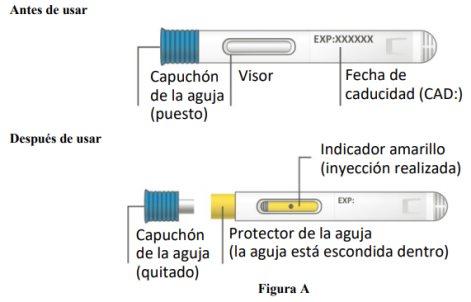
Important information you should know before injecting Pyzchiva
- For subcutaneous injection only(inject directly under the skin)
- Do notremove the needle cap before you are ready to inject.
- Do notshake the prefilled syringe at any time. Shaking the prefilled syringe can damage the Pyzchiva medicine.
Storing the Pyzchiva Prefilled Syringe:
- Store Pyzchiva in the refrigerator (between 2°C and 8°C).
- Keep Pyzchiva in its original carton to protect it from light or physical damage.
- If needed, individual Pyzchiva prefilled syringes can also be stored at room temperature up to 30°C for a maximum of 1 month, keeping them in their original carton to protect them from light. Write the date when you first remove the prefilled syringe from the refrigerator on the space provided on the outer packaging. At any time before the end of this period, the product can be put back in the refrigerator and stored there until the expiration date. Discard the syringe if not used after the maximum 1-month period at room temperature or before the original expiration date, whichever comes first. Do notstore Pyzchiva in extreme heat or cold conditions.
- Do notfreeze.
Preparing the Injection with the Pyzchiva Prefilled Syringe
Step 1. Before you start, check the carton to make sure it is the correct dose.You will be given 45 mg or 90 mg as prescribed by your doctor.
- If your dose is 45 mg, you will receive a 45 mg prefilled syringe.
- If your dose is 90 mg, you will receive a 90 mg prefilled syringe or two 45 mg prefilled syringes. If you receive two 45 mg prefilled syringes for a 90 mg dose, you will need to give two injections, one after the other.
Step 2. Gather your supplies
- Step 2.1:Choose a well-lit, clean, and flat work surface.
- Step 2.2:Gather the supplies you will need to prepare and inject your Pyzchiva injection (Figure B).
- You will need the following supplies.
- Included in the carton:
- Pyzchiva prefilled syringe
- Not included in the carton:
- Alcohol swab
- Cotton balls or gauze pads
- Adhesive bandage
- Sharps disposal container (see "How to dispose of the Pyzchiva Prefilled Syringe").
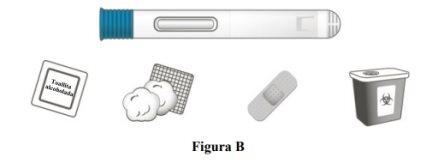
Step 3. Inspect the Prefilled Syringe (Figure C)
- Step 3.1:Check the expiration date on the prefilled syringe or carton.
- Step 3.2:Check for particles or a change in color of the medicine through the viewing window. The medicine should look clear and colorless to pale yellow with a few white particles.
- Step 3.3:Make sure the syringe is not damaged.
- Do notuse Pyzchiva if:
- the expiration date has passed or if the prefilled syringe has been stored at room temperature up to 30°C for a maximum of 1 month or if the prefilled syringe has been stored above 30°C;
- it is frozen, discolored, cloudy, or contains large particles;
- it is damaged;
- it has fallen and is cracked or broken.
- It is normal to see 1 or more bubbles in the viewing window.

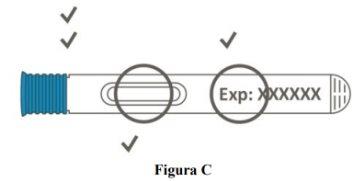
 Step 4. Allow the medicine to reach room temperature
Step 4. Allow the medicine to reach room temperature
- For a more comfortable injection, let the Pyzchiva prefilled syringe reach room temperature for about 30 minutes before injecting, after taking it out of the refrigerator.
- Do notwarm up the prefilled syringe in any other way (for example, do not warm it up in the microwave or in hot water).
Step 5. Wash your hands
- Wash your hands well with warm water and soap (Figure D).
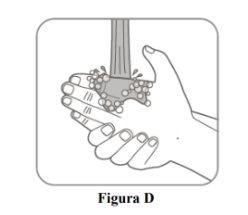
Step 6. Choose the injection site
- Choose an injection site around the thighs or the lower abdomen (lower stomach area), at least 5 centimeters away from the navel. If you are a caregiver giving the injection, you can also give it in the outer area of the arms. (Figure E)
- Use a different injection site for each injection.
- Do notinject into an area of the skin that is sensitive, bruised, red, or hard or that shows signs of psoriasis.
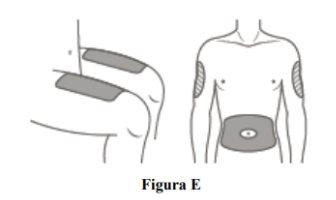
Step 7. Clean the skin at the injection site
- Clean the skin with a new alcohol swab at the injection site. (Figure F)
- Do nottouch this area again before injecting. Let the skin dry before injecting.
- Do notfan or blow on the cleaned area.
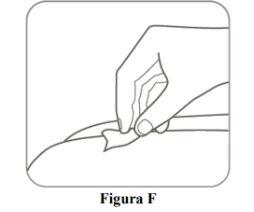
Injecting with the Pyzchiva Prefilled Syringe
Step 8. Remove the needle cap when you are ready to inject Pyzchiva (Figure G).
- Discard the needle cap.
- It is normal for a few drops of liquid to come out of the needle.
- Do nottwist or bend the needle cap while removing it, as this could damage the needle.
- Do notuse the prefilled syringe if it has fallen after removing the needle cap. Call your healthcare professional for instructions.
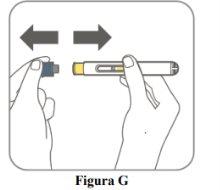
Step 9. Place the prefilled syringe directly on the skin at 90 degrees (Figure H).
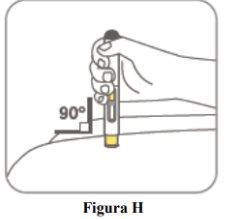
Step 10. Press the prefilled syringe firmly against the skin to start the injection (Figure I).
- You may hear a first click when the injection starts.
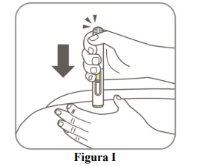
Step 11. Keep pressing against the skin until the yellow indicator stops moving. (Figure J).
The injection may take up to 10 seconds.
- You may hear a second click. This indicates that the injection is complete.
- Do notstop pressing on the injection site until the injection is complete.
- Do notmove the prefilled syringe during the injection.
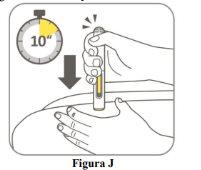
Step 12. Check that the viewing window has turned yellow to make sure you have received the full dose and remove the empty syringe from the skin (Figure K).
- The needle guard will cover the needle completely.
- As shown in Figure K, you may still see a small gray band in the viewing window.
- When you pull the needle out of the skin, you may see a few drops of blood or a small amount of liquid at the injection site. This is normal. If needed, you can press the injection site with a cotton ball or gauze pad. Do not rub the skin at the injection site. If needed, you can cover the injection site with a small adhesive bandage.
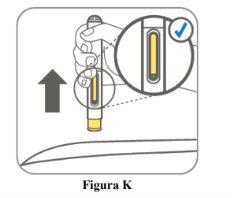
If your dose is 90 mg, you will receive a 90 mg prefilled syringe or two 45 mg prefilled syringes. If you receive two 45 mg prefilled syringes for a 90 mg dose, you will need to give a second injection right after the first. Repeat steps 1-12 for the second injection using a new syringe. Choose a different injection site for the second injection.
How to dispose of the Pyzchiva Prefilled Syringe
Step 13. Put the used syringe in a sharps disposal container immediately after use (Figure L).
- Do notthrow away (dispose of) loose syringes in the trash.
- Do notrecycle the used sharps disposal container.
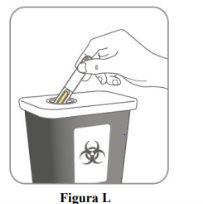
Keep Pyzchiva and all medicines out of the reach of children.
- Country of registration
- Active substance
- Prescription requiredYes
- Manufacturer
- CompositionPOLISORBATO 80 (0,04 mg mg), SACAROSA (85 mg mg)
- This information is for reference only and does not constitute medical advice. Always consult a licensed doctor before taking any medication. Oladoctor is not responsible for medical decisions based on this content.
- Alternatives to PYZCHIVA 90 mg SOLUTION FOR INJECTION IN PRE-FILLED PENDosage form: INJECTABLE PERFUSION, 130 mgActive substance: ustekinumabManufacturer: Accord Healthcare S.L.U.Prescription requiredDosage form: INJECTABLE, 45 mgActive substance: ustekinumabManufacturer: Accord Healthcare S.L.U.Prescription requiredDosage form: INJECTABLE, 90 mgActive substance: ustekinumabManufacturer: Accord Healthcare S.L.U.Prescription required





